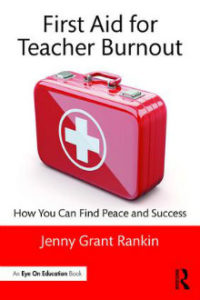Get to Summer Break Without Burning Out
 By Jenny Grant Rankin
By Jenny Grant Rankin
You’re entering the final stretch of teaching your 2017-2018 classes. The school year is more than halfway through, winter vacation breaks are over, and you might find yourself feeling the aches of burnout.
Whether you are a new teacher or a veteran teacher, this is the time of year when a second wind can be a lifesaver. It is not too late to reassess your habits and processes in order to do a burnout-fighting spring cleaning. Consider the following four tactics that can easily be applied mid-year, based on my book First Aid for Teacher Burnout: How You Can Find Peace and Success.
Freshen up Your Classroom
Your first thought might be, “I don’t have time for redecorating! I’m already buried in work!” Yet research findings are conclusive: an uncluttered and inviting classroom improves your mood and performance, as well as those of your students.
Consider ways in which your room isn’t working for you (maybe the flow doesn’t support how you group students for cooperative learning, or maybe a particular corner feels claustrophobic) and plan an improved layout and style. Short on time? Plan to lunch with colleagues in your room while tackling the project, or enlist your family’s help one evening.
Open curtains and unblock windows to let in natural light. (If you don’t have windows, investigate whether changes in your artificial lighting might help). Bring in a cool chair and colorful accents. Introduce colors like blue (promoting tranquility), green (reducing stress and emulating the outdoors), and yellow (promoting happiness and warmth).
Determine your organizational needs and bring in low-cost bins to corral and label papers and supplies. If keeping bulletin boards up-to-date is harassing you, pull down what’s up there and invite kids to post encouraging letters and artwork that celebrate how your class is helpful or meaningful to them.
Rethink Homework
Research is conclusive: there is no correlation between homework and achievement for elementary-school students [though reading time is beneficial, and very minimal assignments help students transition to homework in middle school]. The correlation begins in middle school but only up to 90 minutes per night; and for high school students the correlation between homework and achievement caps at two hours (Pope, Brown, & Miles, 2015).
 Most teachers assign more than this, especially at secondary levels when multiple teachers each independently assign homework on the same nights. This hurts students, and it also hurts the teachers who have to assign, collect, score, and process this homework …. not to mention being haunted by the “homework tote bag” teachers lug home on evenings and weekends.
Most teachers assign more than this, especially at secondary levels when multiple teachers each independently assign homework on the same nights. This hurts students, and it also hurts the teachers who have to assign, collect, score, and process this homework …. not to mention being haunted by the “homework tote bag” teachers lug home on evenings and weekends.
Consider which of your assignments are least worthwhile. Instead of two weeks’ worth of worksheets, try assigning a single project that helps students master content, engages students more, and can be scored in a single sitting.
Give students a rubric ahead of time detailing what to include so you can circle rubric items (rather than write out the same comments) to quickly determine scores and provide feedback. Google “rethink homework” to explore the creative alternatives that abound.
Try a New Classroom Management Strategy
Poor student behavior is one of the most often-reported contributors to teacher burnout. Though it’s challenging to shift behavior dynamics mid-year, it is possible and is far more worthwhile than enduring an out-of-control class or relationship for the rest of the school year.
 Talk to your school leaders about your desire to improve classroom management and ask if you can visit other teachers (those known to be masterful when it comes to student behavior) while they’re in action.
Talk to your school leaders about your desire to improve classroom management and ask if you can visit other teachers (those known to be masterful when it comes to student behavior) while they’re in action.
Talk to these teachers about specific strategies they find most powerful. If you can’t get time away from your own teaching schedule to visit other classrooms, arrange to co-teach a lesson in a larger space, or spend a secondary planning period in another teacher’s classroom if planning times are staggered.
Though I recommend reading books to improve classroom management, books on student/teacher connection can be just as powerful. When students know you value them, understand them, and care too much to give up on them, they can move mountains for you. Select a book or handful of articles likely to help you with student behavior (here’s one at MiddleWeb), pick one to three new strategies to try, and experiment until you find solutions that work for you and your students.
Improve Collaboration
Work volume (creating lessons, searching for resources, etc.) is one of the biggest sources of teacher stress and biggest stealers of personal time. Yet most teachers plan their instruction in isolation, wanting to do things their own way.
I understand this tendency (I’m a Type A perfectionist who planned most of her lessons alone), but it is not sustainable considering the demanding nature of a teacher’s job. Collaboration with colleagues is imperative.
 Pick one or two colleagues who share your same work ethic, content area/grade, and sequence of instruction. Discuss areas in which you can join forces to cut your workload considerably.
Pick one or two colleagues who share your same work ethic, content area/grade, and sequence of instruction. Discuss areas in which you can join forces to cut your workload considerably.
Note this does not mean creating each lesson together (which can be helpful initially, as you mesh your lesson styles, but tends to add work in the long run). Rather, you can “divide and conquer” to save time. For example, perhaps your colleague creates half the units and you create the other half, or maybe you create all the class lessons but your colleague creates the warmup exercises, homework assignments, and quizzes.
Note I write “create” rather than “use the adopted curriculum” because even “standards-aligned” resources are notoriously lacking, and there remains much work for teachers to do to plan instruction that meets all students’ varied needs. To create all aspects of every day’s lessons is too massive an endeavor to tackle alone without eventually experiencing burnout.
Pick a collaboration approach where you honor one another’s strengths, be clear about expectations (when should items be ready, who is doing what, etc.), start small to establish what works best (you can always add collaborators over time), and consider resources and colleagues you find online or at neighboring schools (administrators can often use their connections to help you find these).
Conclusion
Freshening up your classroom, rethinking homework, trying a new classroom management strategy, and improving collaboration are just four tactics teachers can apply late in the school year to fend off burnout. Many more strategies abound. When you feel the mid-year tentacles of burnout trying to pull you down, try one of these to lower your stress and increase your joy.
Teachers are arguably the most important people when it comes to changing this world for the better. You deserve to enjoy your time at work, and to enjoy your time away from work (i.e., have time for a personal life). I wish you the best success in making it to summer break without burning out.
____________________
 Dr. Jenny Grant Rankin teaches the PostDoc Masterclass at University of Cambridge and writes books for educators, such as her recent book titled First Aid for Teacher Burnout: How You Can Find Peace and Success. She has a Ph.D. in Education and has served as an award-winning teacher, school administrator, district administrator, and chief education & research officer. Dr. Rankin won Maryland Teacher of the Year and was honored by the U.S. White House for her dedication to students. She regularly shares research and resources at www.JennyRankin.com.
Dr. Jenny Grant Rankin teaches the PostDoc Masterclass at University of Cambridge and writes books for educators, such as her recent book titled First Aid for Teacher Burnout: How You Can Find Peace and Success. She has a Ph.D. in Education and has served as an award-winning teacher, school administrator, district administrator, and chief education & research officer. Dr. Rankin won Maryland Teacher of the Year and was honored by the U.S. White House for her dedication to students. She regularly shares research and resources at www.JennyRankin.com.



































Great tips! I am helping a first year teacher straighten and decorate his classroom library and we are both finding it to be invigorating! Great way to beat the blah feeling that sometimes precedes burnout.